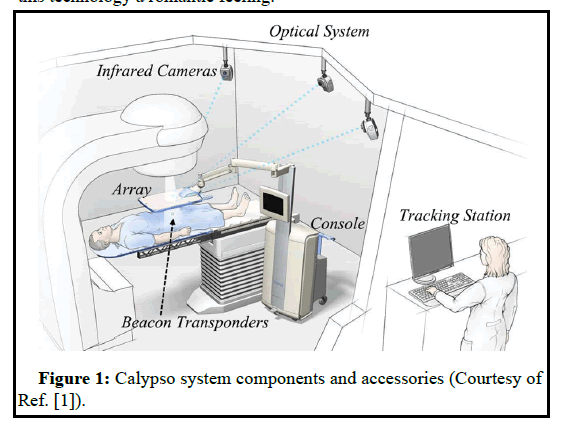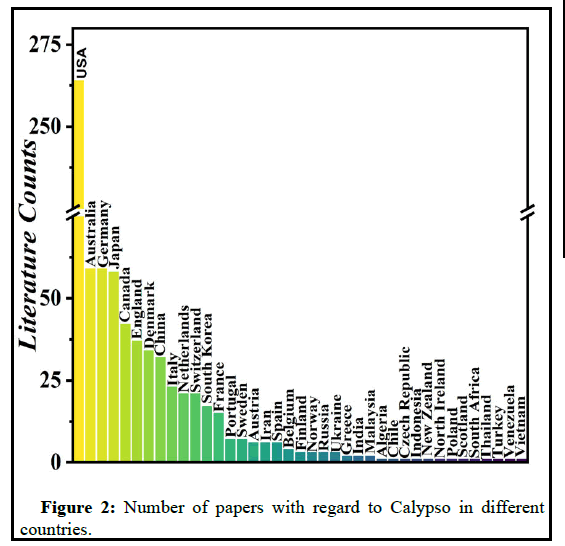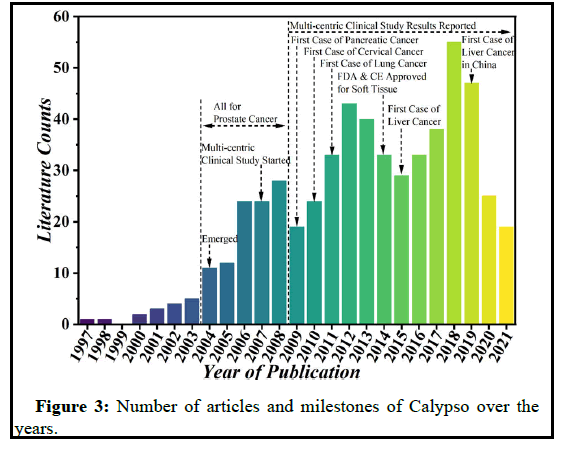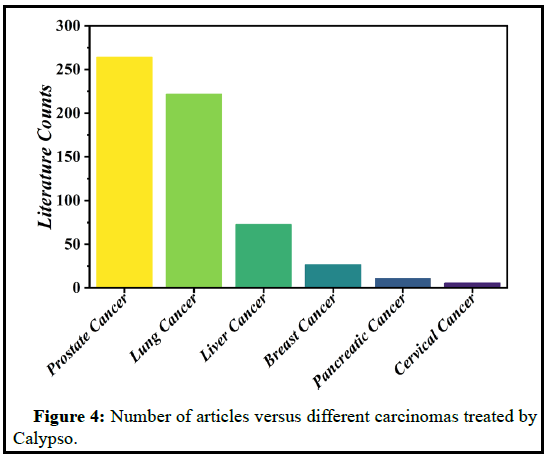A Brief Review of Calypso: Past, Present and Future
Received: 07-Oct-2021 / Accepted Date: 21-Oct-2021 / Published Date: 28-Oct-2021
Abstract
Calypso is an internal electromagnetic motion monitoring technology to localize and track tumors in a real-time and direct way to allow accurate treatment. It has been nearly two decades since its invention and the first Calypsobased stereotactic liver radiotherapy in China was successfully implemented and evaluated in our institution. To thoroughly understand this technology, it is more beneficial to comprehensively investigate the development of Calypso all over the world besides China, which may facilitate the motion management-based radiotherapy methodologies and guide the way for its future applications. In this mini review, a brief description of thorough retrospect, current status analysis and prospect was illustrated. It is shown that Calypso is gradually spreading out from developed countries to developing countries, and it is used for more carcinoma types. It is hoped that this mini review can inspire more Calypso application cases and provide a firm faith in its bright future.
Keywords: Calypso; Radiotherapy; Internal electromagnetic motion monitoring, Beacon transponder; Motion management
Introduction
Calypso, according to Greek mythology, refers to a nymph who lived on the island of Ogygia. In this mini review, the Calypso (Varian Medical Systems, USA) is a motion management technology in radiation therapy which can perform internal electromagnetic motion monitoring. The special name derived from Greek mythology gives this technology a romantic feeling.
As shown in Figure 1, the Calypso system is composed of several parts, including beacon transponders, array, console, tracking station. Firstly, the array transmits electromagnetic signals to the beacon transponders. Secondly, the beacon transponders receive the waves and transmit Radio-Frequency (RF) signals at specific hertz. Lastly, the array detects the RF signal and converts their position displacements to movement curves. With the help of console and tracking station, therapists can observe the movement curves and recognize the real-time offsets of the tumor.
Figure 1: Calypso system components and accessories (Courtesy of Ref. [1]).
Compared to other motion management technologies, such as Active Breathing Coordinator™ (ABC, ELEKTA, Sweden) [2], Real-time Position Management™ (RPM, Varian Medical Systems, USA) [3], Optical Surface Management System (OSMS, Varian Medical Systems, USA) [4], etc. the Calypso system is a real-time and direct approach to localize and track tumors. Therefore, it is expected that this internal motion monitoring approach is more accurate than those external ones.
Due to the advantages of Calypso, the first internal electromagnetic motion monitoring implementation for stereotactic liver radiotherapy in China was successfully implemented and evaluated in our institution [5]. Preliminary research results had been reported. A thorough literature search was conducted with the keyword “calypso & radiotherapy” via the Web of Science, and current status of Calypso in China was briefly described. Nevertheless, it is necessary to investigate comprehensively the development of Calypso all over the world, which may facilitate the motion management-based radiotherapy methodologies and guide the way for its future applications.
By august 25th of 2021, a keyword of “((calypso & radiotherapy) or (electromagnetic tracking and radiotherapy) or (real-time tracking and radiotherapy and internal))” as topics were searched in web of science and refined by document types of articles and reviews only. Totally, 553 results were found. Although there were few papers related to gold and infrared marker, these literatures basically covered most aspects of Calypso through the years.
In this paper, a brief review of Calypso, including its past, present and future trend, was described. It is expected that this comprehensive retrospect, current status analysis and prospect can lead to an improvement in Calypso methodologies to different carcinoma characterization in different countries.
Literature Review
A statistic work was done in advance to reveal dependencies of number of papers, such as countries, years of publication and carcinoma types (Figure 2).
Figure 2 shows the number of papers with regard to Calypso in different countries. It is clearly seen that there are huge differences among countries, especially the USA. The United States ranked the first and way out in front, followed by Australia, Germany, Japan, Canada, England, Denmark and China.
It can be seen that most countries in Figure 2 are developed countries, followed by developing countries. Furthermore, less Calypso cases were reported in some developed countries, such as New Zealand, than that of some developing countries, such as China and India.
It is assumed that availability of Calypso was related to not only economic development levels but also population bases. It is also expected that, with the economic growth, more Calypso cases will be reported especially in developing countries (Figure 3).
Figure 3 shows the number of articles and milestones of Calypso over the years since it is invented. Although there were some records from 1997 to 2003, Calypso was actually emerged around 2004 [6]. At that time, other names such as wireless localization systems and nonionizing target localization systems were also used in addition to Calypso [7-9]. From 2004 to 2006, some QA (Quality Assurance) research papers were published, which were prepared for the following clinical trials [10,11]. Multi-centric clinical studies started from 2007 [12-15]. From 2004 to 2008, all the reports were revolving around prostate cancer.
Successively, the first case of pancreatic cancer with Calypso was reported in 2009 [16]. In the same time, results from clinical trials and multi-institutional studies kept coming out from 2009 [17-20]. Furthermore, the first case of cervical cancer and the first case of lung cancer based on Calypso were reported in 2010 and 2011, respectively [21,22]. The first case of liver cancer through the instrumentality of Calypso was reported in 2015 [23-25], which was closely following the Conformité Européenne marking and US Food and Drug Administration clearance for general implantation in soft issues in 2014.
In general, the number of articles about Calypso reached to its plateau during the period from 2012 to 2019. Possibly due to the COVID-19 pandemic, number of articles related to Calypso started to decrease since 2020. It can be predicted that more reports of Calypso will be published after the pandemic, when the traveling prohibition was released and risks of beacon implantation was lowered. It can also be noticed that Calypso was implemented in prostate cancer in the beginning and spread out to other types of carcinoma gradually, such as pancreatic cancer, cervical cancer, lung cancer and liver cancer. Thus, it is necessary to investigate the number of articles related to different carcinomas in order to recognize the current application status of Calypso (Figure 4).
Figure 4 shows the carcinoma type correlations of literature numbers related to Calypso. It can be seen that most of the reports were about prostate cancer and lung cancer, followed by liver cancer and breast cancer, etc. This may be attributed to that there is a high incidence of prostate cancer in western countries. It is also noticed that there are huge differences among carcinoma types. The number of liver cancer is about a quarter of prostate cancer. It is believed that, with the growing popularity of Calypso, more cases of liver cancer treated by this technology will be reported especially in East Asian countries as the incidence of liver cancer in this area higher than the rest of the world.
Future of calypso
According to the aforementioned retrospect and current status analysis of Calypso, several anticipations can be made. Firstly, Calypso will gradually spread to developing countries, especially those with large populations, such as China and India. Secondly, Calypso will be applied in more types of carcinoma, which are badly in need of motion management such as breast cancer. Thirdly and most importantly, the widespread implementation of Calypso must be based on the premise of the deliberate selection of appropriate patients and the adequate skills of beacon transponder implantation.
Furthermore, in addition to regular radiotherapy procedures, implementation of Calypso includes several extra steps such as CTguided beacon implantation and setup QA. These complicated steps hinder the installation of Calypso in junior hospitals, for instance, infirmaries. It can be anticipated that Calypso will be only applied in major hospitals in the foreseeable future.
Discussion and Conclusion
It has been nearly two decades since the invention of Calypso. In the last seventeen years, Calypso has been booming in developed countries, especially in the United States. What is more, most of the Calypso application cases are in prostate cancers and lung cancers. Nowadays, it begins to spread to developing countries and be utilized in soft tissues such as liver cancer. It is believed that more cases will be reported in aspect of both countries and carcinoma types. To some extent, due to cumbersome and error-prone steps, Calypso is still restricted to be applied in major hospitals. Whereas, it is still promising and its bright future is glad to be prospected.
Conflict of Interest
The authors declare that the research was conducted in the absence of any commercial or financial relationships that could be construed as a potential conflict of interest.
Funding
This work was supported by the China Postdoctoral Science Foundation (Grant No. 2018M632263), Jiangsu Postdoctoral Research Funding Program (Grant No. 2021K422C), Southeast University- Nanjing Medical University Cooperative Research Project (Grant No. 2242018K3DN22) and Postdoctoral Foundation of Jiangsu Institute of Cancer Research (Grant No. SZL201715).
Acknowledgments
The authors thank the therapist group of the Radiotherapy Department of Jiangsu Cancer Hospital for their opinions and experiences in Calypso applications. The authors also thank Miss Vicky Chen for her careful proofreading.
References
- Brock, J, McNair HA, Panakis N, Tayler RS, Evans PM, et al. (2011) The Use of the active breathing coordinator throughout radical Non-Small-Cell Lung Cancer (NSCLC) radiotherapy. Int J Radiat Oncol Biol Phys 81: 369-375.
- Lee TK, Ewald A, Schultz T, Park SY (2014) SU-E-J-253: Evaluation of 4D CT images with correlation of RPM signals to tumor motion for respiratory-gated radiotherapy. Med Phys 41: 216.
- Ma Z, Zhang W, Su Y, Liu P, Pan Y, et al. (2018) Optical surface management system for patient positioning in interactional breast cancer radiotherapy. Biomed Res Int 2018: 1-8.
- Mu Z, Wang Q, Guo C, Feng Y, Gu H, et al. (2021) The First internal electromagnetic motion monitoring implementation for stereotactic liver radiotherapy in china: Procedures and preliminary results. J Cancer Res Clin Oncol.
- Willoughby TR, Kupelian PA, Pouliot J, Hadley SW, Wei JT, et al. (2004) Implant experience and positional stability of ac magnetic beacon transponders used to localize patients for external beam radiation therapy of the prostate. Int J Radiat Oncol Biol Phys 60: S267-S268.
- Burch D, Willoughby T, Meeks S, Levine L, Vertatschitsch D, et al. (2005) Real time prostate translation, rotation, deformation evaluated with calypso beacon transponders. Int J Radiat Oncol Biol Phys 63: S195.
- Kupelian P, Willoughby T, Litzenberg D, Waardenburg MV, Roach M, et al. (2005) Clinical experience with the calypso 4D localization system in prostate cancer patients: Implantation, tolerance, migration, localization and real time tracking. Int J Radiat Oncol Biol Phys 63: S197.
- Kupelian PA, Willoughby T, Mahadevan A, Jani S, Flores N, et al. (2006) 1136 Characterization of real time motion of the prostate gland in patients receiving external radiotherapy for localization prostate cancer: Tracking during 1157 fractions with the calypso system. Int J Radiat Oncol Biol Phys 66: S209-S210.
- Balter JM, Wright JN, Newell LJ, Friemel B, Dimmer S, et al. (2005) Accuracy of a wireless localization system for radiotherapy. Int J Radiat Oncol Biol Phys 61: 933-937.
- Beyer D, Liu D, Flores N, Kupelian P, Willoughby T, et al. (2006) 2290 Efficiency of a non-ionzing target localization system for radiation therapy. I J Radiat Oncol Biol Phys 66: S371-S372.
- Li J, Pollack A, Horwitz E, Buyyounouski M, Price R, et al. (2007) Clinical experience on localization and real-time tracking of the prostate during external radiotherapy using calypso 4D localization system. Int J Radiat Oncol Biol Phys 69: S189.
- Malinowski KT, Parikh PJ, Noel C, Solberg T, Liu D, et al., (2007) Efficient use of a real-time wireless electromagnetic tracking system in the prostate during external beam radiation therapy. Int J Radiat Oncol Biol Phys 69: S325.
- Kupelian P, Willoughby T, Mahadevan A, Djemil T, Weinstein G, et al. (2006) Multi-institutional clinical experience with the Calypso System in localization and continuous, real-time monitoring of the prostate gland during external radiotherapy. Int J Radiat Oncol Biol Phys 67: 1088-1098.
- Williams E, Najib MM (2007) Pcn2 assessing the net health outcomes of a 4D electromagnetic tumor tracking system during radiotherapy for clinically localized prostate cancer: A Health technology assessment of the calypso 4D localization system with beacon transponders. Value in Health 10: 173-222.
- Metz JM, Kassaee A, Ingram M, Plastaras J, Vapiwal N, et al. (2009) First report of real-time tumor tracking in the treatment of pancreatic cancer using the calypso system. Int J Radiat Oncol Biol Phys 75: S54-S55
- Mantz CA, Fernandez E, Zucker I, Harrison S (2010) A Phase II trial of real-time target tracking SBRT for low-risk prostate cancer utilizing the calypso 4D localization system: Patient reported health-related quality of life and toxicity outcomes. Int J Radiat Oncol Biol Phys 78: S57-S58.
- Wang K, Vapiwala N, Scheuermann R, Plastaras J, Bar V, et al. (2010) Comprehensive study on real-time prostate gland motion between patient groups undergoing radiotherapy with and without daily endorectal balloon. Int J Radiat Oncol Biol Phys 78: S683-S684.
- Mantz CA, Fernandez E (2013) Real-time target tracking prostate SBRT and the real-time tracking system 4D localization system: 5-Year quality of life and disease outcomes. Int J Radiat Oncol Biol Phys 87: S393.
- Mantz C (2014) A Phase II trial of stereotactic ablative body radiotherapy for low-risk prostate cancer using a non-robotic linear accelerator and real-time target tracking: Report of toxicity, quality of life, and disease control outcomes with 5-year minimum follow-up. Front Oncol 4: 279.
- Gatcombe HG, Liu T, Chen H, Godette KD, Diaz R, et al. (2010) Calypso 4D localization and cone-beam CT evaluation of cervical motion during external beam radiotherapy for intact cervix cancer. Int J Radiat Oncol Biol Phys 78: S41-S42.
- Bolliger CT, Koegelenberg CFN, Groote-Bidlingmaier FV, Papachristofilou A, Schratzenstaller U, et al. (2011) First report of implantation of anchored electromagnetic fiducials in human lung cancers for real-time tumor localization and tracking during radiation therapy. Int J Radiat Oncol Biol Phys 81: S578-S579.
- James J, Cetnar A, Nguyen V, Wang B (2015) MO-F-CAMPUS-J-02: Commissioning of radiofrequency tracking for gated SBRT of the liver using novel motion system. Med Phys 15: 3582.
- Poulsen PR, Worm ES, Hansen R, Larsen LP, Grau C, et al. (2015) Respiratory gating based on internal electromagnetic motion monitoring during stereotactic liver radiation therapy: First results. Acta Oncol 54: 1445-1452.
- James J, Cetnar A, Dunlap NE, Huffaker C, Nguyen VN, et al. (2016) Technical note: Validation and implementation of a wireless transponder tracking system for gated stereotactic ablative radiotherapy of the liver. Med Phys 43: 2794-2801.
Citation: Mu Z, Xia Y (2021) A Brief Review of Calypso: Past, Present and Future. J Oncol Res Treat S5:001.
Copyright: © 2021 Mu Z, et al. This is an open-access article distributed under the terms of the Creative Commons Attribution License, which permits unrestricted use, distribution, and reproduction in any medium, provided the original author and source are credited.
Select your language of interest to view the total content in your interested language
Share This Article
Open Access Journals
Article Usage
- Total views: 3419
- [From(publication date): 0-2021 - Dec 08, 2025]
- Breakdown by view type
- HTML page views: 2721
- PDF downloads: 698




